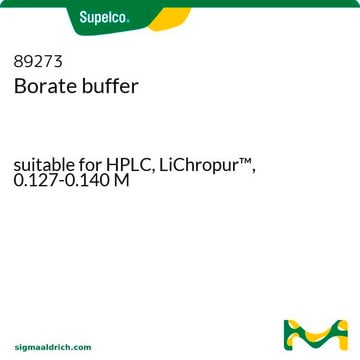If this product has an expiration or retest date, it will be shown on the Certificate of Analysis (COA, CofA). If there is no retest or expiration date listed on the product's COA, we do not have suitable stability data to determine a shelf life. For these products, the only date on the COA will be the release date; a retest, expiration, or use-by-date will not be displayed.
For all products, we recommend handling per defined conditions as printed in our product literature and website product descriptions. We recommend that products should be routinely inspected by customers to ensure they perform as expected.
For products without retest or expiration dates, our standard warranty of 1 year from the date of shipment is applicable.
For more information, please refer to the Product Dating Information document: https://www.sigmaaldrich.com/deepweb/assets/sigmaaldrich/marketing/global/documents/449/386/product-dating-information-mk.pdf
B6768
Acide borique
BioReagent, for molecular biology, suitable for cell culture, suitable for plant cell culture, ≥99.5%
Sélectionner une taille de conditionnement
Sélectionner une taille de conditionnement
About This Item
Produits recommandés
Qualité
for molecular biology
Niveau de qualité
Pression de vapeur
2.6 mmHg ( 20 °C)
Gamme de produits
BioReagent
Essai
≥99.5%
Forme
powder
Technique(s)
cell culture | mammalian: suitable
cell culture | plant: suitable
pH
5.1 (25 °C, 1.8 g/L)
Pf
160 °C (dec.) (lit.)
Solubilité
water: 40 mg/mL, clear, colorless
Densité
1.49 g/cm3 at 23 °C
Traces de cations
Fe: ≤5 ppm
Mg: ≤5 ppm
heavy metals (as Pb): ≤10 ppm
Absorption UV
λ: 260 nm Amax: 0.05
λ: 280 nm Amax: 0.05
Activité étrangère
DNase, RNase, and protease, none detected
Température de stockage
room temp
Chaîne SMILES
OB(O)O
InChI
1S/BH3O3/c2-1(3)4/h2-4H
Clé InChI
KGBXLFKZBHKPEV-UHFFFAOYSA-N
Vous recherchez des produits similaires ? Visite Guide de comparaison des produits
Description générale
Application
- to prepare boric buffer for the quantification of primary amine groups at the surface of nanocapsules
- to study its effects on epigenetic change
- for the estimation of protein in wheatgrass using Kjeldahl method
Intensified Azeotropic Distillation: A Strategy for Optimizing Direct Amidation
Caractéristiques et avantages
- Environment-friendly
- Non-toxic
Mention d'avertissement
Danger
Mentions de danger
Conseils de prudence
Classification des risques
Repr. 1B
Code de la classe de stockage
6.1C - Combustible acute toxic Cat.3 / toxic compounds or compounds which causing chronic effects
Classe de danger pour l'eau (WGK)
WGK 1
Point d'éclair (°F)
Not applicable
Point d'éclair (°C)
Not applicable
Équipement de protection individuelle
Eyeshields, Gloves, type P3 (EN 143) respirator cartridges
Listes réglementaires
Les listes réglementaires sont principalement fournies pour les produits chimiques. Seules des informations limitées peuvent être fournies ici pour les produits non chimiques. L'absence d'indication signifie qu'aucun des composants n'est répertorié. Il incombe à l'utilisateur de s'assurer de l'utilisation sûre et légale du produit.
EU REACH SVHC Candidate List
EU REACH Annex XVII (Restriction List)
Faites votre choix parmi les versions les plus récentes :
Déjà en possession de ce produit ?
Retrouvez la documentation relative aux produits que vous avez récemment achetés dans la Bibliothèque de documents.
Les clients ont également consulté
-
How can I determine the shelf life / expiration / retest date of this product?
1 réponse-
Utile ?
-
-
How is shipping temperature determined? And how is it related to the product storage temperature?
1 réponse-
Products may be shipped at a different temperature than the recommended long-term storage temperature. If the product quality is sensitive to short-term exposure to conditions other than the recommended long-term storage, it will be shipped on wet or dry-ice. If the product quality is NOT affected by short-term exposure to conditions other than the recommended long-term storage, it will be shipped at ambient temperature. As shipping routes are configured for minimum transit times, shipping at ambient temperature helps control shipping costs for our customers. For more information, please refer to the Storage and Transport Conditions document: https://www.sigmaaldrich.com/deepweb/assets/sigmaaldrich/marketing/global/documents/316/622/storage-transport-conditions-mk.pdf
Utile ?
-
-
How can I find out the expiration date? Lot No : BCCH1940
1 réponse-
Expiration information will be on the certificate of analysis. The certificate of analysis can be accessed by clicking on the "COO/COA" tab under the product photo the product detail page or the scrolling down to the documentation section. Here is a copy of lot BCCH1940 COA: https://www.sigmaaldrich.com/certificates/sapfs/PROD/sap/certificate_pdfs/COFA/Q14/B6768-BULKBCCH1940.pdf.
This product does not contain an expiration date or recommended retest date. Products with no expiration date or recommended retest date should be routinely inspected by customers to ensure they perform as expected. These products are also subject to a one year warranty from the date of shipment. For more information you may access the "Product Dating Information" document under "ADDITIONAL USEFUL DOCUMENTS ABOUT OUR PRODUCTS" at the bottom of the Quality Services page with this link: https://www.sigmaaldrich.com/US/en/life-science/quality-and-regulatory-management/quality-services
Utile ?
-
Filtres actifs
Notre équipe de scientifiques dispose d'une expérience dans tous les secteurs de la recherche, notamment en sciences de la vie, science des matériaux, synthèse chimique, chromatographie, analyse et dans de nombreux autres domaines..
Contacter notre Service technique








